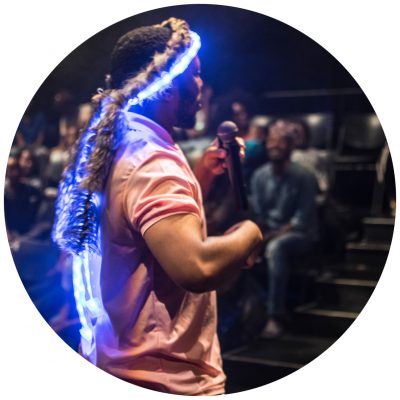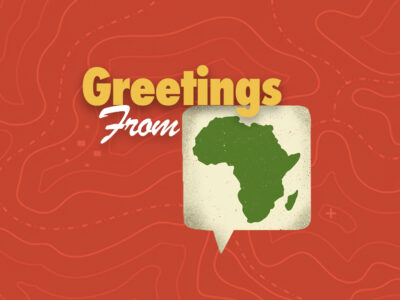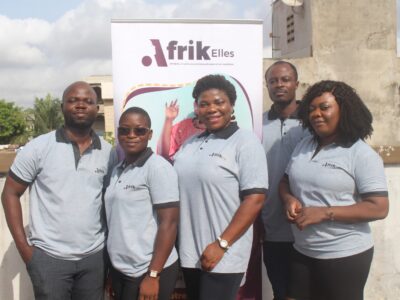
Sary nomen'i Siya Masuku.
Ao anatin'ny fanentanana fanandratana ny fimaroam-piteny an-tserasera amin'ity taona 2019 ity, hifandimby ireo mpikatroka sy mpanandratenin'ny fiteny afrikana hitantana ny kaonty Twitter @DigiAfricanLang hizara ny zava-niainay tamin'ny famelomana aina indray sy ny fampiroboroboana ny fiteny afrikana. Ny lahatsoratra etoana dia hiresaka momba an'i Siya Masuku (@siyamasuku) sy izay kasainy horesahana mandritra ny herinandro maha-mpampiatrano azy.
Rising Voices: Lazalazao anay ny momba anao azafady.
Soweto-born Siya Masuku ran a 113% successful online crowdfunding campaign in July and August 2016 to launch his own publishing platform, Siyafunda Online. The alphabet book, Siyafunda: isiZulu (2016), has colourful images of lino printed animals. It is available with English translations in print and digital formats.
Siya has collaborated with Book Dash South Africa to illustrate children’s books; UDaisy Omangalisayo (2015) and Isitsha Samakhekhe Masiwe (2016). He recently collaborated with Puku Children’s Literature Foundation to illustrate and design the books, Mosidi (2019) and The Wolf and the Fox (2019).
A recipient of the David Koloane Arts Writing Award (2017), Siya is a self-published comics writer and illustrator of uNjabulo: emkhathini (2017) and uLanga (2019).
Namelona fanangonam-bola antserasera nahomby 113% tamin'ny jolay sy aogositra 2016 i Siya Masuku teraka tao Soweto hananganany ny sehatra famoahany manokana antsoina hoe Siyafunda Online. Ahitana sarimbiby miloko milahatra ny boky abidia Siyafunda: isiZulu (2016). Ahitana dikantsoratra amin'ny teny anglisy izany amin'ny vita pirinty sy amin'ny endrika nomerika.
Niarahan'i Siya niasa ny Book Dash South Africa handravahana ny bokin'ny ankizy: UDaisy Omangalisayo (2015) sy Isitsha Samakhekhe Masiwe (2016). Vao haingana izy no niasa niaraka tamin'ny Orina Mpanasoa Literatioran'Ankizy Puku handravahana sy hanomezana endrika boky Mosidi (2019) sy Ny Amboadia sy ny Fosavazaha (2019).
Nahazo tombony tamin'ny Fifaninanana Fanoratana Zavakanto David Koloane (2017), Siya ihany no nanoratra sy namoaka boky tantara an-tsary sy fandravahana an'i uNjabulo: emkhathini (2017) sy uLanga (2019)
RV: Manao ahoana ny toerana misy ny fiteninareo amin'ny aterineto sy ivelan'izany?
Zulu, a culture of the Zulu people (amaZulu) should not be confused with isiZulu (the language). There are between 10 – 12 million isiZulu speakers in Southern Africa. IsiZulu is the most widely spoken home language in South Africa. It became one of South Africa’s 11 official languages in 1994. There are at least 35 indigenous languages in South Africa.
English remains the more commonly used language across the internet. However, platforms which offer services by isiZulu tutors, courses and programs are accessible online. Siyafunda Online is one such platform.
Tsy azo afangaro amin'ny isiZulu (ilay fiteny) ny Zulu kolontsain'ny vahoaka Zulu (amaZulu). Manodidina ny 10_12 tapitrisa ny mpiteny isiZulu manerana ny atsimon'i Afrika. IsiZulu no fiteny iresahana indrindra ao an-trano aty Afrika Atsimo. Lasa iray amin'ny fiteny ofisialin'i Afrika Atsimo miisa 11 izany tamin'ny taona 1994. Farafahakeliny 35 ny fitenin-janatany eto Afrika Atsimo.
Ny Anglisy no fiteny fampiasa indrindra amin'ny aterineto. Na izany aza dia azo jerena antserasera ny sehatra manolotra servisy ho an'ny mpampianatra, ny lesona ary ny programa isiZulu. Iray amin'ny sehatra toy izany ny Siyafunda Online.
RV: Lohahevitra manao ahoana no kasainao ifantohana mandritra ny herinandro hitantananao ny kaonty Twitter @DigiAfricanLang?
Some of the topics in mind
- Narratives – no longer telling stories about hut dwellers and cattle herders, it’s now stories about tech savvy township and suburban people
- Pronunciation as the primary way to learn a language
- Phonics – using alliteration, assonance and repetition to learn isiZulu
- Language nuances – clan names, metaphors, ideophones
- Innovation – provocative artwork, new stories (untranslated), learning whilst having fun (launches, magic, poetry), improvising (motion comics, gaming)
- Vocabulary – new words to learn. Some are borrowed based on how we exchange information today
- Animal vs Human languages in comics – “humans speaking human; animals speaking animal”
- Message – stories which continuously ask questions, probing the reader to conclude or do more research, unsung heroes, mischief, dreaming, curiosity, parenting, friendship, caring, love, hope
Ny sasany amin'ny lohahevitra ao an-tsaina
Fitantarana – tsy mila miresaka mipetraka an-trano bongo sy miandro omby intsony, tantaram-pahaizana teknolojia an-tanàna mivangongo sy olona an-tanàna itatra indray izao
Fanonona ho lalana voalohany hianarana ny fiteny
Feo mampiasa ny fiverimberenam-peondrenintsoratra, fiverimberenam-peonjanatsoratra ary famerimberenanteny hianarana isiZulu
Fangarom-piteny – anarana foko, fanoharana, feonkevitra
Fanavaozana – zavakanto mihantsy, tantara vaovao (tsy voadika), sady mianatra no miala voly (fitarihan-dresaka, majika, poezia), fahaiza-mamorona eo noho eo (sarimiaina, lalao)
Voambolana – teny vaovao ianarana. Ny sasany nindramina araka ny fifanakalozam-baovao amin'izao fotoana izao
Ny fitenim-biby sy ny fitenin'olombelona ao amin'ny tantara an-tsary – “olombelona miteny amin'ny olombelona; biby miteny amin'ny biby”
Hafatra – Tantara tsy mitsahatra ny manontany, mampikotrika ny mpamaky hanao fehinteny na hanao fikarohana bebe kokoa, maherifo mbola tsy fantatra, mpanakorontana, manofinofy, liandiana, mitaiza, finamanana, fikarakarana, fitiavana, fanantenana.
RV: Inona no tena mandrisika anao havitrika hanandratra ny fiteninareo? Inona ny fanantenanao sy ny nofinofinao ho amin'ny fiteninareo?
I hope indigenous languages continue to evolve. They are forced to, regardless, in order to stay alive. It is when we shift our perspective from a preservation-based approach to one which is associated with boldness and curiousness that the language and its people open up to new possibilities.
IsiZulu has nuances other languages cannot interpret. Let us let it take shape naturally in a single story through print, song, performance art, gaming, augmented reality and other mediums of modern communication.
Manantena aho fa hivoatra ny tenin-janatany. Voatery ho izany raha te-ho velona. Rehefa miova fomba fijery avy amin'ny fomba fiasa mitahiry ny teo aloha mankany amin'ny mifandraika amin'ny fahasahiana sy ny fahalianana isika no manokatra faravodilanitra vaovao ny fiteny sy ny olony.
Manana fangaro tsy hain'ny fiteny hafa adika ny isiZulu. Avelao horanitina ao anaty tantara mandeha irery amin'ny alalan'ny pirinty, hira, fanatontosana zavakanto, lalao, zavamisy notovonana ary ireo endrika fampitam-baovaon'ny fifandraisana maoderina izany.





